
Salad Bars: Procurement
The menu drives everything in procurement. If there is one area that derails food expenses, it is a lack of commitment to menu cycle development. If salad bars are added to current meal costs without any change to the menu cycle, the resulting expense of labor and food will be unsustainable. The most successful programs using salad bars are those that incorporate the salad bar as the primary “go-to” for vegetable side dishes and fruits.

Salad Bars: Procurement
The menu drives everything in procurement. If there is one area that derails food expenses, it is a lack of commitment to menu cycle development. If salad bars are added to current meal costs without any change to the menu cycle, the resulting expense of labor and food will be unsustainable. The most successful programs using salad bars are those that incorporate the salad bar as the primary “go-to” for vegetable side dishes and fruits.
Menu cycles should be developed with the understanding that if hot vegetable sides are retained daily, then the department budget may not be able to absorb the increased cost of salad bars (unless there is also an increase in participation). Since every district is different, we cannot generalize about what one district can or cannot support, but the primary strategy is to be accountable for the changes ahead of time, track new program costs closely, and adjust if you are not on target.
Food Cost
Impact to Food Cost
Fruit and vegetable serving requirements, which require every student take a minimum of a half-cup serving of fruit or vegetable, increase produce costs in many districts. In districts with established salad bars, impact to food cost in the fruit and vegetable category is minimal, as student behavior has shifted to selecting vegetables and fruits as part of their everyday routine. If implementing a first-time salad bar, it is important to think about how food costs will change.
One of the biggest impacts of adding a salad bar as part of the reimbursable meal is a change in how fresh fruit and vegetable products are purchased: fresh versus frozen or canned. One of the most common questions from Salad Bars to Schools program grantees is “How do we plan for purchases?” We recommend planning the department’s food budget based on average menu costs for all meal types, which includes salad bar (see Food Costs page for more details). Essentially, your food budget should be based on an average cost per meal by type multiplied by the number of projected reimbursable meals for the coming year. When adding a totally new feature like salad bars, it’s important to remember that rolling over the prior year’s food expenses as the budget cost projection is not accurate enough to protect from under-budgeting food costs.
Salad bars can transform your approach to menu planning and help identify which aspects of the menu to replace. When adding salad bars to your lunch program, you need to analyze the cost of the fruit and vegetable sides offered in your current lunch menus. As long as the salad bar will replace current fruit and vegetable side costs in your future menu cycles, a reasonable budget is possible and fairly straightforward to project. In analyzing food costs around the country, we find that fruit sides average $0.18 to $0.30 per serving, and vegetable sides are similar.
Forecasting Purchases
Forecasting Produce Purchases for RFPs (Requests for Proposals)
As mentioned earlier, without historical data it is a challenge to predict the exact volume for ingredients offered regularly on the salad bar, but it’s not impossible to forecast produce purchases to guide through the first year. The change in procurement practices will vary based on the practices and menus of the district prior to implementing salad bars.
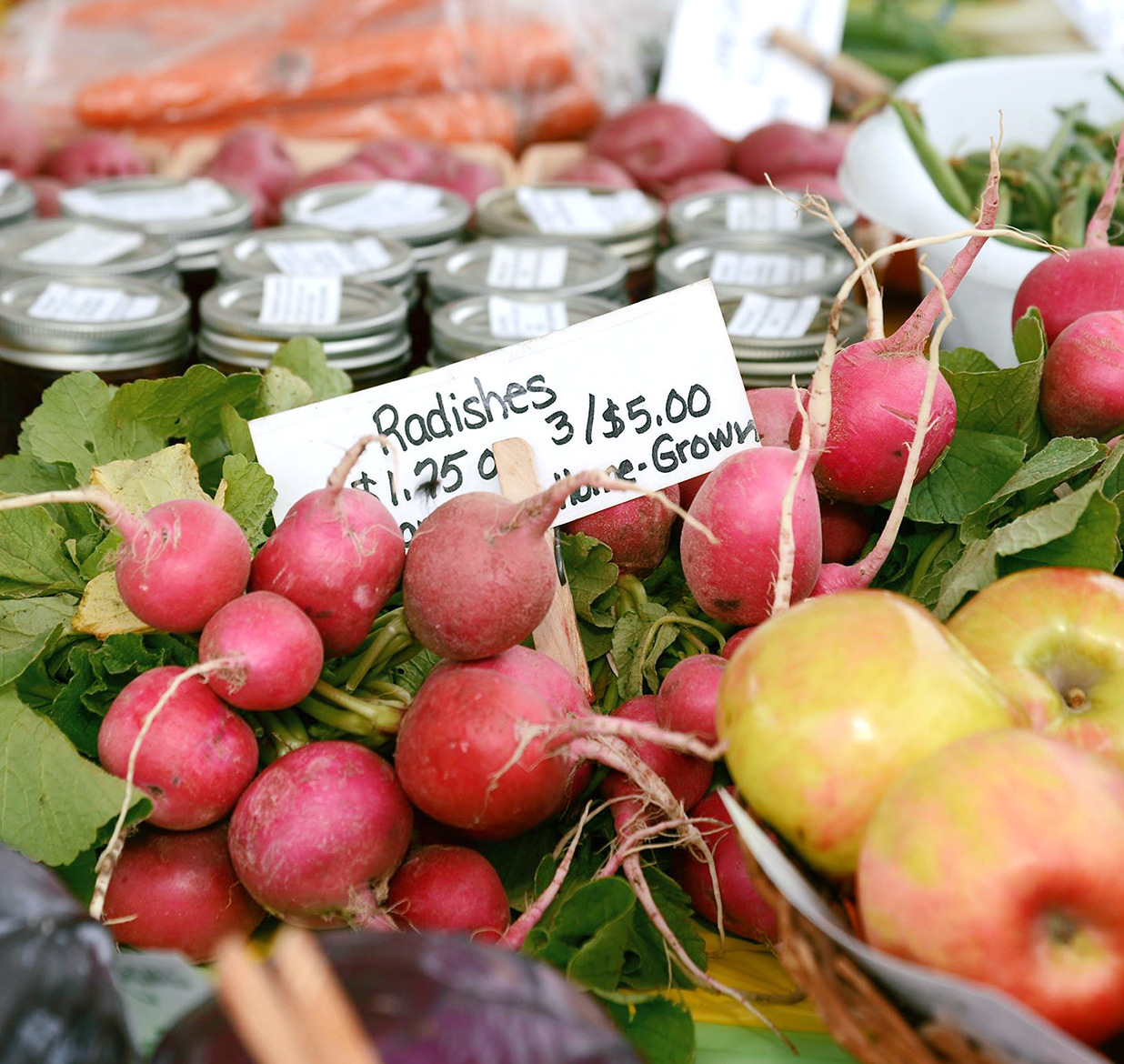

Forecasting Purchases
Forecasting Produce Purchases for RFPs (Requests for Proposals)
As mentioned earlier, without historical data it is a challenge to predict the exact volume for ingredients offered regularly on the salad bar, but it’s not impossible to forecast produce purchases to guide through the first year. The change in procurement practices will vary based on the practices and menus of the district prior to implementing salad bars.
If a district serves a lot of fresh product before introducing a salad bar, the change will not be as dramatic compared to a district that primarily used canned and frozen product. The use of USDA foods and the DoD Fresh Fruit and Vegetable program should also be considered in your overall procurement plan.
Analyze your purchases, commodity, and DoD records to establish how much volume in current lunch menus is attributable to fruit and vegetables. If you use digital production records, you can export production data that accurately reflects fruits and vegetables served at each meal period. You can align those numbers with your purchase and commodity history to estimate a fairly accurate volume of produce served over a set period of time. If you don’t have digital production records, use a large sampling of paper records to manually calculate a percentage of fruit and vegetables served. This percentage can be applied to the purchase volume to arrive at a reasonable estimate of fruit and vegetable usage at each meal.
Collecting this information establishes a baseline of past practices (which is very useful for future evaluation), as well as some realistic projections for fruit and vegetable volume when preparing for a salad bar model. For districts that have less experience with fresh fruits and vegetables, the conversion of canned and frozen to fresh--with regard to projecting how many cases or pounds of product they may need--is a particular challenge. The following exercise will help you develop a realistic RFP for produce and determine the cost of the salad bar ingredients compared to your current practices.
- Step 1: Analyze Prior Practices
- Step 2: Organize the Data by Food Type
- Step 3: Determine the Volume by Meal Type
- Step 4: Determine Your Salad Bar Menu
- Step 5: Project Product Volumes for Your RFP
Step 1: Analyze Prior Practices
Depending on what time of year it is, you’ll either want to analyze the prior year’s purchase data or the current year. If it is late February or beyond, use the current year and develop an estimate for the remainder of the year based on the menu volume (servings), Average Daily Participation (ADP), and current vendor costs.
What Do You Need?
Lunch Production Data
As discussed above, production data provides the actual usage in current pre-salad bar menus. Given current regulations, students must take a fruit or vegetable at minimum, so your lunch ADP is the baseline to help with volume estimates, though actual production data is most accurate.
Vendor Velocity Data
This is a report that your vendor can export from their system. You’ll want to see the full school year, July 1 through June 30. It’s a by-item report (see examples below), so ask for an Excel or csv file to easily sort and add columns. If you use a back-office program that receives invoices, that would be a suitable alternative, but velocity reports are excellent tools and it should be standard practice to receive them monthly as well as annually from your vendors for tracking purposes.
USDA Food Received Report
Export a detailed “received” commodity report from WBSCM or whichever tool your state has developed for USDA commodity records.
DoD Fruit and Vegetable Program
Download a detailed received report for the school year from the FAVORS website (the site where you order the DoD.).
Current Menu Cycles
These reflect the year represented by the purchase data.
Future Menu Cycles
See Cycle Planning Steps.
Salad Bar Menu
See Menu Planning for salad bars.
District Calendar
Pull calendars from the period that you are analyzing. You’ll need to know the number of serving days by month and year.
Breakfast and Lunch ADP
Use the total for the district as well as the school for the year analyzed. If you serve snack or supper you will need those numbers as well. (Use Simple Meal Count / Average Daily Participation Worksheet [Spanish Version] to calculate.)
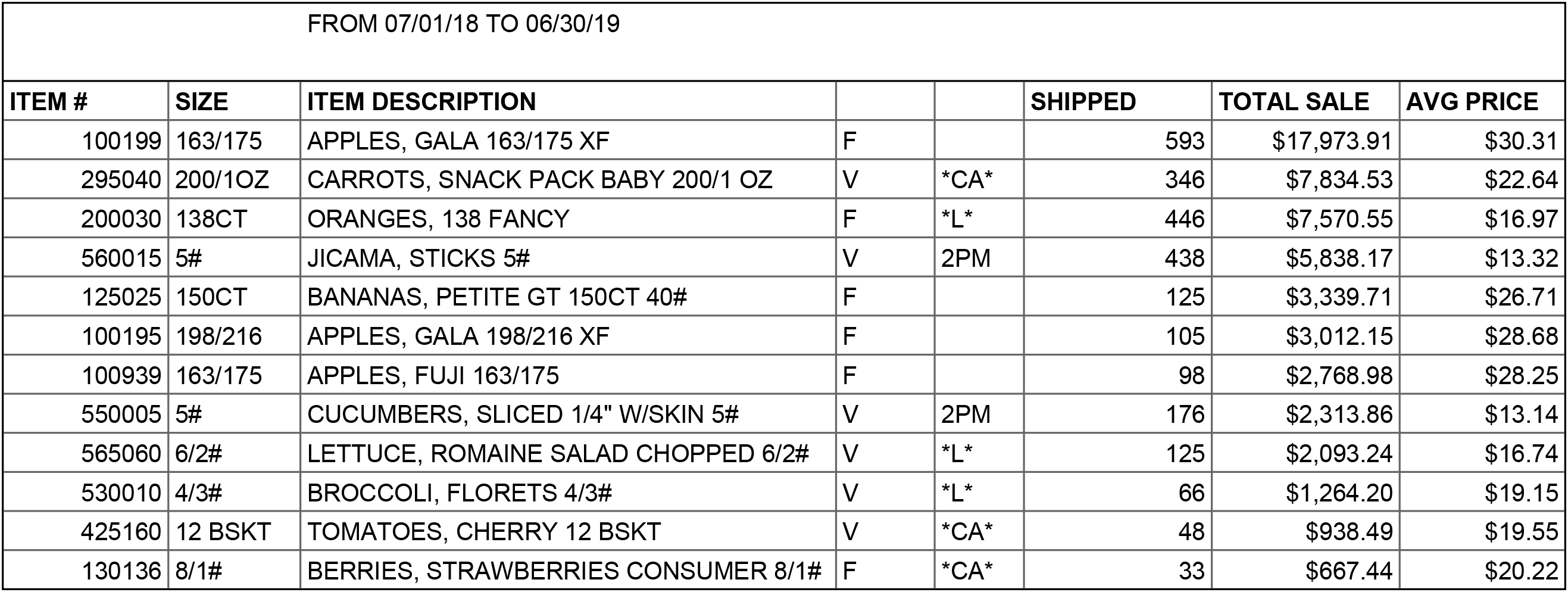
Produce vendor velocity report

Prime vendor velocity report sorted by product type

Step 2: Organize the Data by Food Type
Using the reports listed above, organize the data by type (fruit or vegetable) and also by sub-category (fresh, frozen, or canned). This data will be for all meals that you serve—breakfast, snack, and lunch.
The data will reflect all meal types. If there are products that are specifically only served at breakfast or snack, eliminate that data since it does not affect lunch food planning. If you have a USDA Fresh Fruit and Vegetable Program (FFVP) and purchase or track that procurement separately, you can eliminate those items from the spreadsheet as well.

Step 2: Organize the Data by Food Type
Using the reports listed above, organize the data by type (fruit or vegetable) and also by sub-category (fresh, frozen, or canned). This data will be for all meals that you serve—breakfast, snack, and lunch.
The data will reflect all meal types. If there are products that are specifically only served at breakfast or snack, eliminate that data since it does not affect lunch food planning. If you have a USDA Fresh Fruit and Vegetable Program (FFVP) and purchase or track that procurement separately, you can eliminate those items from the spreadsheet as well.
Step 3: Determine the Volume by Meal Type
Presumably, there will be some overlap of items that are used in breakfast, snack, and dinner. The next step is to isolate the fruit and vegetable purchases by menu category: breakfast, lunch, snack and dinner (if served). A la carte produce sales will also need to be isolated if you sell produce in addition to any of your meals.
The most accurate way to determine fruit and vegetables served by meal type is to use the “items served or used” history from the production records. However, if you do not use digital production records and your menu cycles repeat the same fruit and vegetables throughout, it is reasonable to analyze a week’s worth of production records to extrapolate approximately how much fruit and vegetable is attributable to each meal type. The goal is to understand what percentage of your fruit and vegetable volume is attributable to each meal.
| MEAL TYPE | SERVINGS OF FRUIT | SERVINGS OF VEGGIES |
|---|---|---|
| Breakfast | 20% | 0% |
| Lunch | 70% | 95% |
| Snack | 10% | 5% |
| Supper | 0% | 0% |
| TOTAL | 100% | 100% |
Step 4: Determine Your Salad Bar Menu
In your launch year, you may want to keep your salad bar menu plan simple so you can easily develop realistic volume projections for a producer vendor RFP.
Yes, the salad bar provides lots of opportunity to showcase many choices, but we still recommend keeping it simple at first. Anchor your bars with standard selections and then choose some rotating ingredients that may be more seasonally driven or more expensive and offered less frequently.


Step 4: Determine Your Salad Bar Menu
In your launch year, you may want to keep your salad bar menu plan simple so you can easily develop realistic volume projections for a producer vendor RFP.
Yes, the salad bar provides lots of opportunity to showcase many choices, but we still recommend keeping it simple at first. Anchor your bars with standard selections and then choose some rotating ingredients that may be more seasonally driven or more expensive and offered less frequently.
Step 5: Project Product Volumes for Your RFP
With your menu cycle planned and your salad bar menu identified, you can determine the highest-volume items to request for pricing in your produce RFP. Salad bars can be challenging because every student takes a different combination of products.
Until you have historical data, you may be nervous, but in your inaugural year, you will be pleasantly surprised with your launch if you keep salad bar selections moderate, track all production, and allow enough time to train the students and encourage them to try new foods.
In the district example below, breakfasts were pre-packaged and juice was used as the fruit (pre-current regulations). They did have a fresh fruit and vegetable program, but those purchases were made under a separate contract, so isolating their fruit and vegetable use at lunch was fairly easy. Due to the size of the district sample, we summarized the item detail. Their actual purchase of fruit and vegetable was approximately $0.41 per lunch meal daily, which is far more than what is needed to implement a salad bar program.
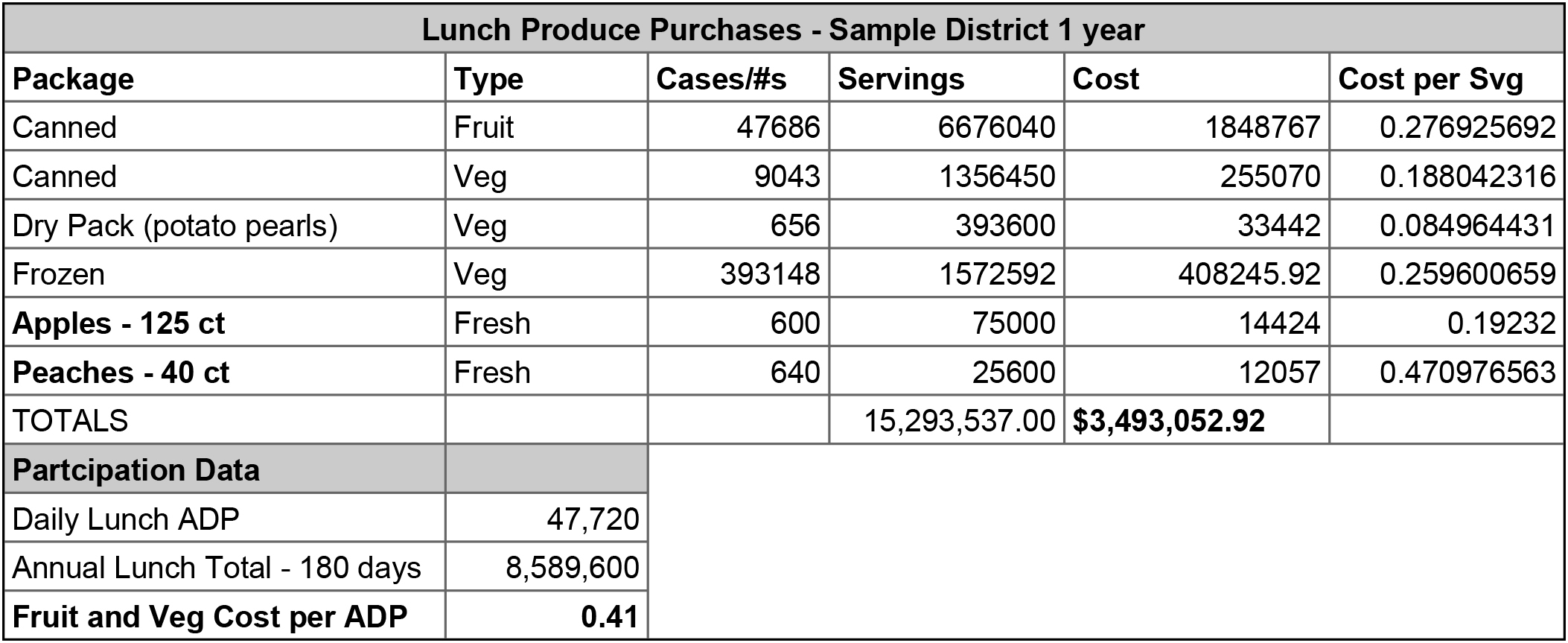
Sample produce purchasing data from one year in a large district
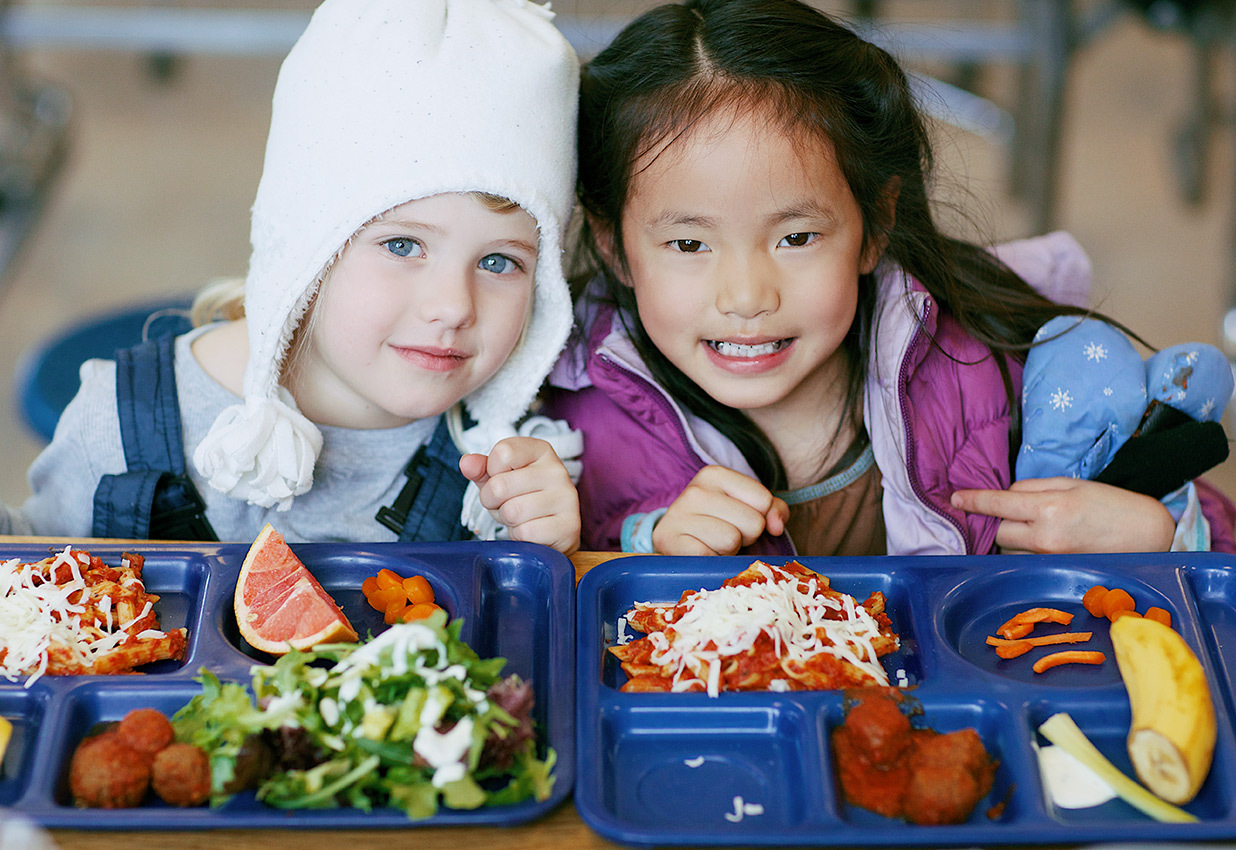
Case Study
Salad Bar Item Cost Case Study
Once you’ve started operating salad bars in your district, you can perform much more detailed cost analysis if you maintain daily records. In our salad bar item cost case study, we did a cost analysis of salad bar consumption in a sample district’s elementary schools using the by-item production record discussed earlier.
| SALAD BAR ITEM | PAN SIZE | TOTAL FITS/PAN | Used (Total Mon–Fri) | Unit Cost | Weekly Cost |
|---|---|---|---|---|---|
| Garbanzo Beans, USDA | 1/4 Pan | 61 oz | 154.0 | 2.12 | 326.48 |
| Broccoli | 1/4 Pan | 26 oz | 38.3 | 3.26 | 124.70 |
| Carrots | 1/4 Pan | 20 oz | 134.1 | 0.66 | 88.51 |
| Celery | 1/4 Pan | 28 oz | 139.5 | 2.39 | 333.41 |
| Chicken, diced USDA | 1/4 Pan | 32 oz | 90.0 | 0.33 | 29.70 |
| Corn, USDA | 1/4 Pan | 32 oz | 111.0 | 0.66 | 73.26 |
| Cottage Cheese | 1/4 Pan | 64 oz | 99.2 | 7.09 | 702.97 |
| Eggs, chopped | 1/4 Pan | 24 oz | 61.1 | 1.1 | 67.21 |
| Jicama | 1/4 Pan | 28 oz | 71.3 | 1.1 | 78.46 |
| Peas, USDA | 1/4 Pan | 40 oz | 66.8 | 1.02 | 68.09 |
| Peppers, green | 1/4 Pan | 20 oz | 62.2 | 1.99 | 123.78 |
| Potatoes, roasted | 1/4 Pan | 32 oz | 88.0 | 0.86 | 75.68 |
| Salad Mix - romaine | 1/2 Pan | 32 oz | 235.3 | 2.73 | 642.37 |
| Salad Mix - spring | (Same Pan) | 8 oz | 46.8 | 1.83 | 85.55 |
| Salad, brown rice | 1/4 Pan | 2.5 qt | 25.9 | 4.64 | 120.18 |
| Salad, tabouli | 1/4 Pan | 1.5 qt | 23.3 | 2.24 | 52.08 |
| Dressing, balsamic | Bottle | 24 oz | 38.1 | 1.64 | 62.48 |
| Dressing, Italian | Bottle | 24 oz | 33.3 | 1.46 | 48.55 |
| Dressing, ranch | Bottle | 24 oz | 139.8 | 0.95 | 132.76 |
| TOTAL WEEKLY COST | 3236.20 | ||||
| 22,000 Meals | APPROX. COST/SVG | 0.15 |
The costing example was aggregated from a week of onsite production data in 28 elementary schools for a total of 22,000 reimbursable meals served. When analyzing the actual used portion for a typical week, the cost-per-serving at the elementary level was $0.15. Secondary school salad bar cost-per-meal averages--using the same method of accounting--were $0.35.
In this analysis, fruit was factored separately. We recommend costing the salad bar without the fruit because:
- The components are separated on the production record.
- Most districts have good production data on fruit consumption because they count the fruit individually.
- For budget purposes, it is preferable to plan the budget presuming that every student will take fruit and salad bar vegetable components.
In this district, protein was also included in the salad bar layout. Since different proteins were offered on different days, the averages from this type of data collection allow the district to capture a fairly precise view of their real costs and volumes used in the menu.
The assumption in this model is that salad bar items are offered as part of the reimbursable meal to every student and the student can return to the bar for seconds. In the sample district, purchases of fresh produce used in salad bars and in scratch cooking shifted from 4% of food purchases prior to salad bar implementation to 24% of food purchases in the first year they ran salad bars in all sites and removed a majority of the manufactured foods. The increased volume of fresh produce was balanced by abandoning canned vegetables, all baked french fry products, and most canned fruit; a deep reduction in juice; as well as an increase in scratch cooking. So even though salad bars will increase your produce purchases, if fully embraced within menu planning, it will replace other purchase categories and become a truly sustainable choice.
Vendor Relationships
Many school districts have never posted a solicitation for their produce purchases. Why? They may not have thought it warranted a specialized vendor; total procurement may fall below the requirement for competitive procurement; they may just be in the habit of receiving produce as part of their prime vendor bid; or they limit their produce procurement to allocation through the DoD Fresh Program.
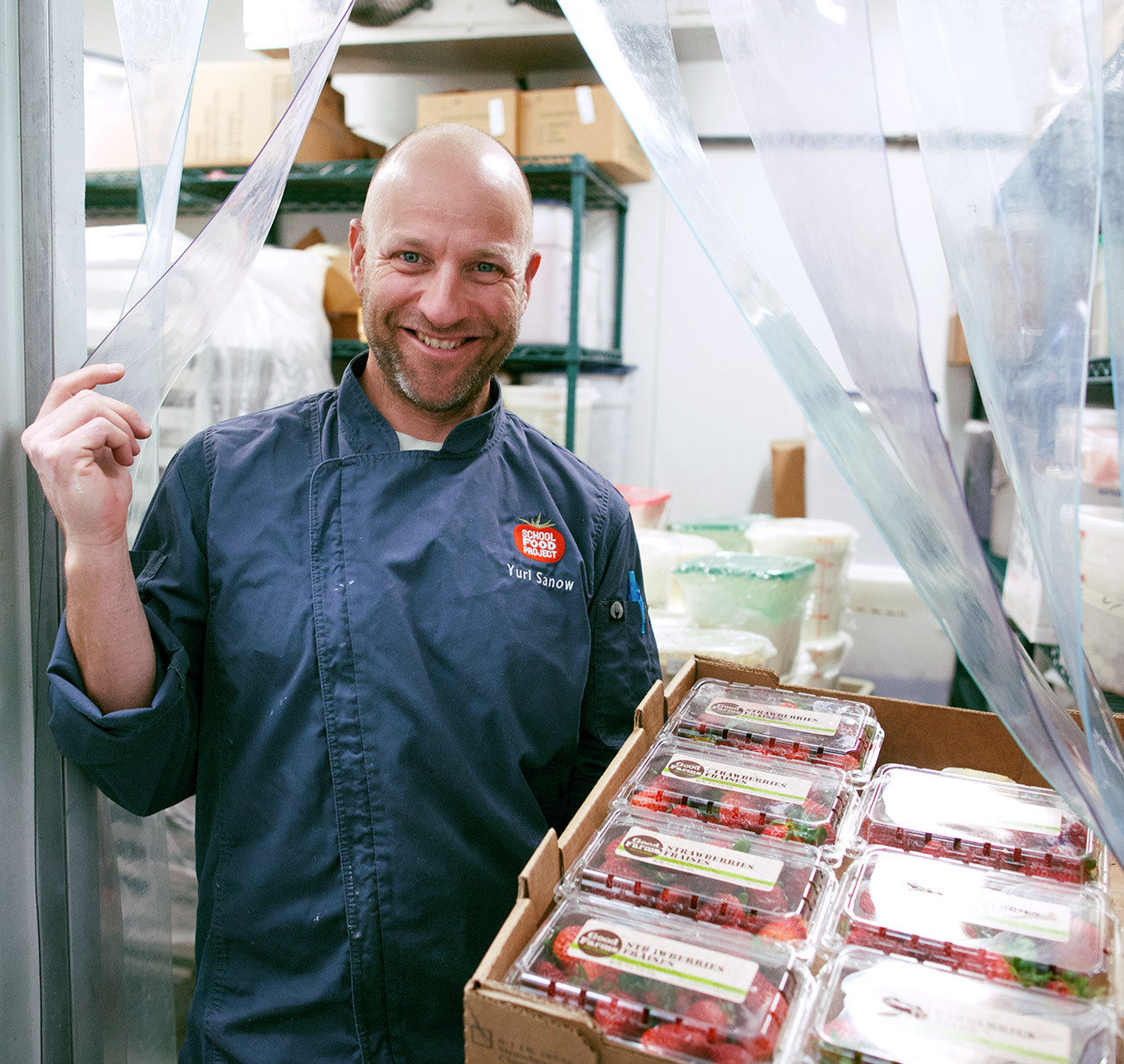

Vendor Relationships
Many school districts have never posted a solicitation for their produce purchases. Why? They may not have thought it warranted a specialized vendor; total procurement may fall below the requirement for competitive procurement; they may just be in the habit of receiving produce as part of their prime vendor bid; or they limit their produce procurement to allocation through the DoD Fresh Program.
Once salad bars are introduced into a district (particularly larger districts), produce procurement becomes serious business, so we recommend developing a Request for Proposal (RFP) that outlines the district’s requirements. RFPs differ from bids, primarily because there are more considerations than just the lowest bid. This is especially pertinent with produce because the price of many products fluctuates throughout the growing season. Selecting a produce vendor strictly on the lowest bid may mean a lower level of quality. Here are three examples of RFPs:
Deciding which vendor to purchase from will depend in part on the delivery model for the district, or the delivery model that local vendors can provide. Ideally, you want to encourage as much competition between vendors as possible, but realistically the delivery model can often determine how many vendors will respond to your RFP. Your RFP needs to be very clear on the requirements for delivery.
For example: a district with multiple sites prepping their own product for salad bars needs to receive deliveries directly to the sites, provided minimum purchase levels can be reached, and the vendor is willing to deliver to multiple sites. The biggest challenge for produce vendors is the delivery window that schools require. Unlike private industry, schools only have Monday through Friday service (with a relatively short window of business hours compared to restaurants), frequent breaks in the year, and many three-day weekends. All of these can pose a challenge to vendor relationships, but “relationship” is the key word; schools may represent a challenge with regard to delivery and other unique criteria, but they also provide an opportunity for a large volume of sales and reliable payment to the chosen vendor.
Pricing Agreements
Produce differs from other food items due to various factors:
- It is highly seasonal and relies on the weather to a degree that many products do not.
- It is perishable.
- There are a lot of products to choose from.
When school districts solicit for responses to their RFPs, it is often a year ahead of the agreement term, so asking a vendor to bid a set price on 30 products a year in advance is simply not in sync with the industry. As an alternative, there are two commonly used practices for produce pricing: short-term bidding and cost-plus pricing.

Short-term bidding
The district requires vendors to provide a price list for a determined length of time. It can be weekly, bi-weekly, monthly, etc. In this arrangement, the district is typically assured of benefiting from the lower costs of in-season produce. The downside is the time and bandwidth to monitor the bids, presuming that multiple companies respond. If there are not multiple bids, then there is no real incentive for competition.

Cost-plus pricing
Requires the vendor to determine a flat rate per case that is added to the cost of the product. This arrangement is more transparent and makes it easier to ascertain that certain products aren’t carrying the cost of the contract. For example, in a conventional low bid contract, a vendor could low bid the five most frequently purchased items, but mark-up items that are purchased less frequently. With this cost-plus model, the district requires that the vendor provide copies of their quarterly purchase records to the district for a pre-determined list of products. This audit of the vendor’s costs maintains transparency of the transactions and assures an open vendor relationship.
Request for proposals should include
- Primary district contact for response to the RFP
- Date when proposals are due
- Date when vendors will be notified of decision
- List of schools and addresses
- Preferred delivery day, time of delivery, and any other information that a vendor should know about each delivery location
- Explanation about how the RFPs will be evaluated or scored
- School calendar highlighting all school breaks and closures requiring an alternative delivery schedule
- List of products, their specification, and projected annual quantity
- Request for records of the vendor’s purchase price by case of your top 10 products (in volume) over the last three quarters
- Identification of your requirements with regard to Country of Origin
- Identification of any other preferences such as local sourcing, identification of farms, sending weekly market reports, etc.
In addition to this information, be sure to include standard contractual language used by the district as well as all federally required contract language.
Staying Local
There are tremendous opportunities to use the salad bar as a showcase for local seasonal foods and nutrition education. In fact, several well-known salad bars were established primarily to serve local foods in the schools as a means to integrate food education within the cafeteria. In California, the best-known examples are in Davis, Santa Monica, and Riverside; these districts specifically designed their procurement around local farm relationships. Given their close proximity to the primary growing area for produce in the United States, their ability to source local foods year-round is very different than in regions with colder temperatures or that are not within historically agricultural regions.
Other limiting factors of local farms include lack of a distribution system and lack of scale (i.e., not enough of the needed product grown to garner a competitive price or meet the district’s demand.) Despite these limitations, local produce is a growing industry in regions all over the country and the salad bar is a perfect place to showcase and educate students about the significance of local foods.
Recommended Next Topic: Salad Bar Operations
Moving from concept to operation can be overwhelming. The overwhelmingly popular use of salad bars in school food service usually disproves the concern that salad bars cost more to operate than a traditional line.
Recommended Next Topic: Salad Bar Operations
Moving from concept to operation can be overwhelming. The overwhelmingly popular use of salad bars in school food service usually disproves the concern that salad bars cost more to operate than a traditional line.






